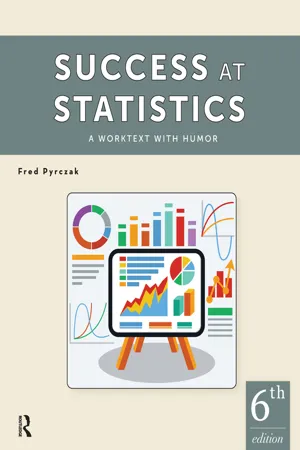
- 502 pages
- English
- ePUB (mobile friendly)
- Available on iOS & Android
About this book
• This comprehensive text covers all the traditional topics in a first-semester course.
• Divided into 67 short sections, this book makes the topics easy to digest. Students regularly get positive reinforcement as they check their mastery with exercises at the end of each section.
• Each exercise is based on a humorous riddle. If the answer to a riddle makes sense, students know all their answers for that exercise are correct. If not, they know they need to check their answers.
• Short sections make it easy to customize your course by assigning only those sections needed to fulfill your objectives.
• A comprehensive basic math review at the end of this book may be used to help students whose math skills are rusty.
• Thoroughly field-tested for student interest and comprehension. The short sections and humor-based, self-checking riddles are greatly appreciated by students.
• Contains Part D on effect size, which provides technical solutions to issues raised in Part C (such as the limitations of inferential statistics).
New to this edition:
Section 1: Explains the importance of statistical techniques in the advancement of scientific knowledge.
Section 11: Section 27: Section 30: Section 41: Appendix J: Table 1:
Frequently asked questions
- Essential is ideal for learners and professionals who enjoy exploring a wide range of subjects. Access the Essential Library with 800,000+ trusted titles and best-sellers across business, personal growth, and the humanities. Includes unlimited reading time and Standard Read Aloud voice.
- Complete: Perfect for advanced learners and researchers needing full, unrestricted access. Unlock 1.4M+ books across hundreds of subjects, including academic and specialized titles. The Complete Plan also includes advanced features like Premium Read Aloud and Research Assistant.
Please note we cannot support devices running on iOS 13 and Android 7 or earlier. Learn more about using the app.
Information
Section 23 Introduction to Sampling
- A professor wants to study the attitudes of all sophomores at a college (the population) but asks only those enrolled in her introductory psychology class (the sample) to participate in the study. Note that only those who are in the class have a chance of being selected. All other sophomores have no chance.
- A politician wants to predict the results of a citywide election (the population) but queries the intentions of only voters whom he encounters in a large shopping mall (the sample). Note that only those in the mall whom he decides to approach have a chance of being selected. All other voters have no chance.
- A magazine editor wants to determine the opinions of all rifle owners in the United States (the population) on gun-control measure but mails questionnaires only to those who subscribe to her magazine (the sample). Note that only subscribers have a chance to respond and that all other rifle owners have no chance.
Table of contents
- Cover
- Title
- Copyright
- Contents
- Introduction
- PART A Descriptive Statistics
- PART B Inferential Statistics
- PART C Putting It All Together
- PART D Effect Size
- PART E Supplement
- Appendices
- Tables
- Index